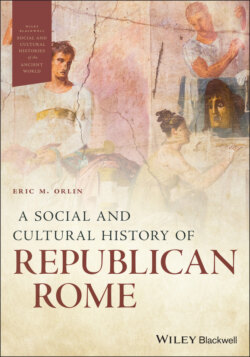Читать книгу A Social and Cultural History of Republican Rome - Группа авторов - Страница 32
Early, Middle, and Late Republics
ОглавлениеThe beginning of the Early Republic seems clear enough – it begins with the downfall of the monarchy in 509 BCE – but there is no clear end-point. Historians focused on internal developments see the unifying characteristic as the conflict between the patricians and plebeians and place the end-point at 287 BCE. This is the date assigned to the lex Hortensia, the Roman law that on this view ended the Struggle of the Orders. Others use a military perspective and prefer to end the Early Republic in 264 BCE. In this year the Romans sacked the Etruscan town of Volsinii and eliminated the last challenge to their power over the Italian peninsula. In the same year they launched an attack on Sicily that marked the beginning of the First Punic War, Rome’s first overseas military conflict and thus the first step in her acquisition of a territorial empire and control over the Mediterranean basin. The fact that historians have difficulty agreeing on a unifying characteristic suggests that perhaps there was not one, although we should also acknowledge that our evidence for this period is so limited that we may not be able to see it clearly.
The Middle Republic begins in the third century, wherever one chooses to end the Early Republic, and is generally agreed to end in 133 BCE with the tribunate of Tiberius Gracchus. This period is the one that might be referred to as the “classical Roman Republic,” when the Roman government operated in the way that the elite Romans thought it should operate. That meant that power was shared among the elite of Rome, an elite that included wealthy persons of plebeian birth as well as noble-born patricians, and that the lower classes of Rome generally followed the lead of the elites. Externally the period was marked by Roman imperialism and the dramatic increase in the amount of territory subject to Roman power. In this period Rome conquered what is now Italy north of the Po River, Carthage, Spain, Greece, and Asia Minor, culminating with the twin sacks of Carthage and Corinth in 146 BCE. In 133 BCE, the Romans could justly refer to the Mediterranean Sea as mare nostrum, our sea.
The Late Republic is considered to run from 133 BCE to the battle of Actium in 31 BCE, and its unifying feature was the erosion of governmental institutions and the use of violence to resolve internal political matters, as described above. From the Gracchi to the Social War to Marius and Sulla to Caesar and Pompey to Antony and Octavian, this period was marked by a series of civil wars, whether in the civic spaces of Rome or on battlefields in Italy and overseas. We might even view this entire period as one approaching anarchy, as whatever written and unwritten rules that governed Roman society changed with such frequency that stability was hard to find. The triumph of Octavian/Augustus at Actium placed him in a position of sole military authority over the Roman state, just as Caesar had been after his victory over Pompey. Augustus, however, proved more successful in creating a stable system of government, inaugurating the period we know as the Roman Empire that lasted into the fifth century CE.
